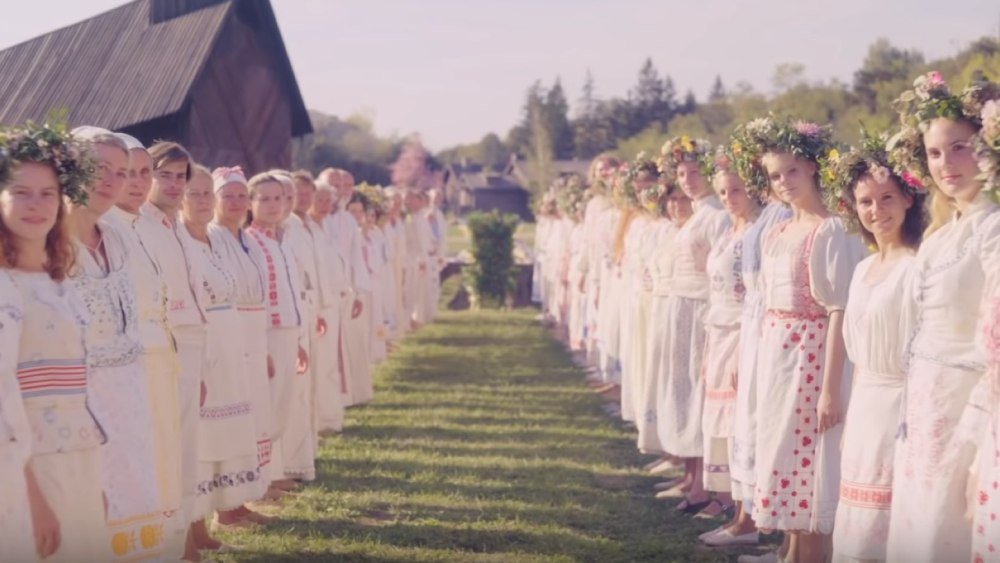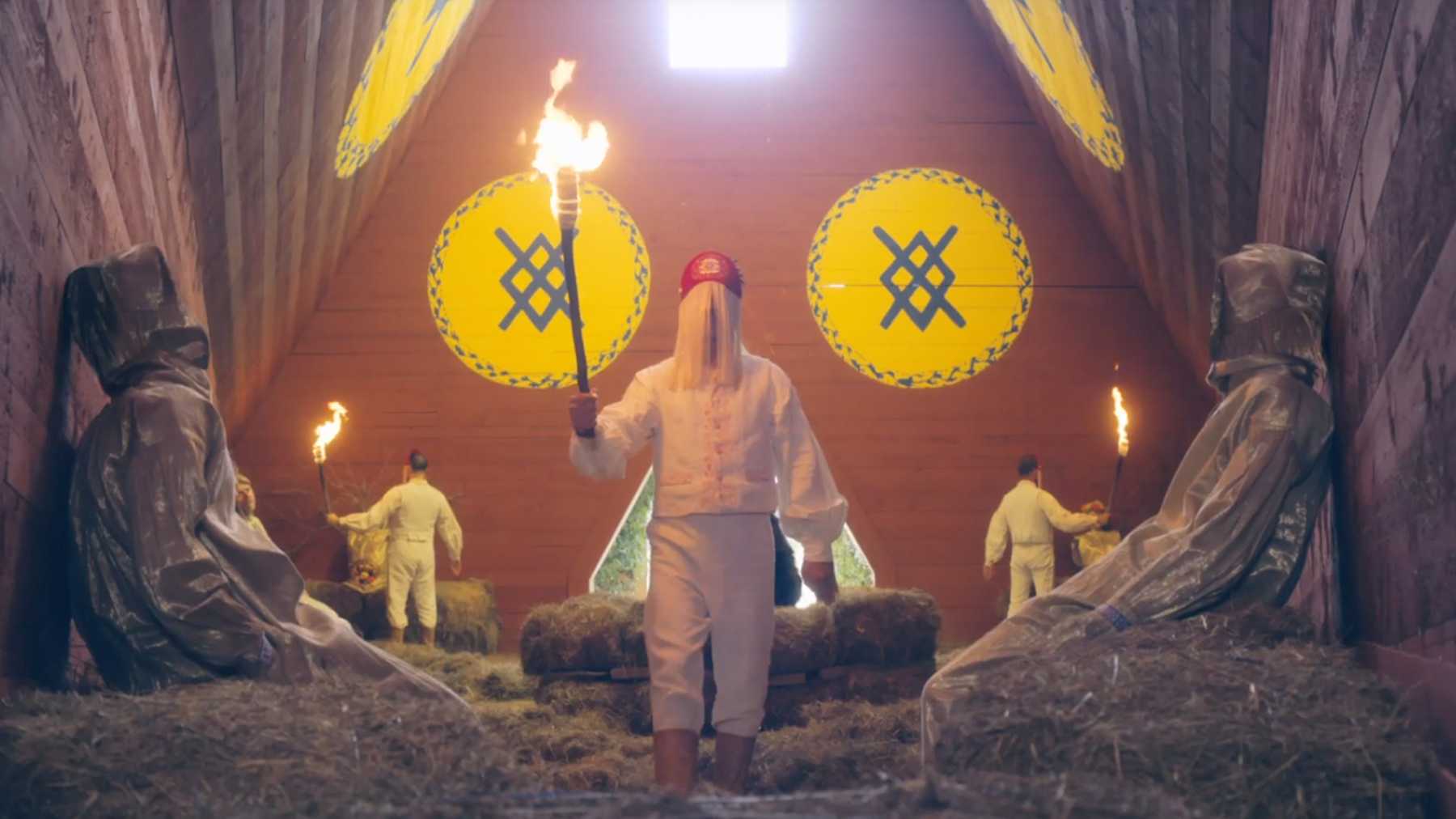Dawn Kiefer is the editor of a weekly Southwest Wisconsin newspaper. She is a lifelong film enthusiast, particularly of psychological horror and the macabre, as well as an avid collector of vintage fashion dolls and paper dolls. Her university studies had an emphasis in journalism and art history. This is the third in a three-part series of essays on Ari Aster’s Midsommar. Read Parts One and Two here.
Ari Aster’s “Midsommar” is the type of film that requires multiple viewings. There are so many layers of intrigue and embedded clues that it would be nearly impossible to pick up on everything the first time one sees it. I have seen it six times so far, and each time I noticed different things and developed alternate hunches. However, from the start, I have been convinced that bringing Dani into the Hargas’ fold was the primary goal and that the deaths of her family were not a murder-suicide, although they were definitely meant to appear that way.
After my first couple of viewings I thought that Pelle arrived at a U.S. university intending to seek suitable prospects for sacrifice and then settled upon Christian, Josh and Mark as likely dupes; with Dani being a lucky bonus to the “package deal.”
But subsequent viewings began to erode at that notion.
Among the nagging doubts I had were the following. Why was Ulf included with Ingemar, when the elder stated to them, “You brought outside offerings, thus volunteering your own bodies” (as live cult sacrifices). Who were the two Hargas effigies supposed to depict, which were proclaimed to be “already dedicated” for the sacrificial pyre? Why did Dani “see” her mother among the Hargas offering congratulations on her May Queen victory?

Gradually a whole new hypothesis emerged in my mind.
We do know that Pelle lured the four Americans and Ingemar lured the two British students to Harga. The young American woman was the only one of those six people to survive; with all of the other persons mentioned above becoming four of the five required sacrificial victims, and ultimately as well as the fifth, who was chosen by the May Queen. How does Ulf fit into that equation? How did he “bring outside offerings”?
I propose that he was involved in an intricate plot to ensure that the four Americans would agree to accompany Pelle to Harga. The two most in question of going were Christian and Dani. I think that Josh would’ve gone in any case and Mark might have or might not have, possibly based on whether or not Christian went. I further address the concept of the group’s decision to go later in this essay.
Repeated viewings have caused me to offer what may be startling assertions.
I posit that Mr. and Mrs. Ardor originally were Hargas family members; which is to say that they had been in the cult, but defected and moved to the U.S. And I submit that the Ardors had adopted Dani.

Before the reader rolls up their eyes and groans, I ask that they continue reading as I spell this out.
Going forward with the idea that Mr. and Mrs. Ardor had been former Hargas members, I propose that their left-behind fellow cult members kept tabs on them over the years. This could easily have been accomplished with reconnaissance by young cult members who were on their pilgrimages, as well as by accessing social media accounts.
In these ways, the Hargas would’ve known that the Ardors had a daughter and (I suggest) adopted another young girl. With the 90-year-interval major sacrificial event looming, the Hargas homed in on the Ardor family.
In this scenario, one of the goals was to sacrifice Mr. and Mrs. Ardor—who, during the preamble to the sacrificial pyre, were represented as effigies dubbed “already dedicated.”
The other goal would be to acquire Dani.
I believe that her having been adopted would allow for her to genetically be new blood for Hargas breeding stock. We know that the Hargas sometimes “bring in outsiders,” because a commune man tells Christian that’s how they avoid incestuous bloodlines. (With the purposeful exception of creating “unclouded” oracles, such as Ruben.)
Supposing that I might be correct in my hypothesis that Dani had been adopted, I suggest that her adoption would’ve taken place when she was in adolescence. Perhaps her parents were either dead or incapable of caring for her and she’d been placed in foster care. Coming from an empathetic background, former Hargas members the Ardors might’ve taken her in found that she was a good companion for their daughter Terri and decided to legally adopt her.
What put the idea into my head that Dani might have been adopted is as follows. When the firefighters enter the Ardor house in response to what appears to have been a murder-suicide, the camera shows us a few family photos. One is of the elder Ardors posed with Dani and Terri, in what appears to be a fairly recent photo. Another photo is of the parents alone and a third photo is of one little girl. I did not see a separate photo of a second little girl. Of course, this is not conclusive and it could mean something else; such as that the parents favored one girl over the other.
I remind readers, though, that Aster is meticulous about details and in recorded interviews about “Midsommar” he and actors Jack Reynor (Christian) and Florence Pugh (Dani) avidly urge viewers to “look at the walls.” They more so are referring to the walls of the Hargas’ buildings, but why would there be less meaning attached to what we’re shown in the Americans’ dwellings? For example, we see posters in Dani’s apartment that portend what will happen; particularly the one by famed Swedish artist John Bauer, which shows a little girl with a large bear. In any case, I posit that both girls were introverts and homebodies. Large stacks of books can be seen in both Terri’s room and Dani’s apartment. That characteristic will be revisited later in this essay.
Assuming that the Ardors previously were in the cult, with Terri having been born elsewhere than the Harga commune, she is an outsider (but without the desired ‘new blood’). Perhaps the cult views Dani as a replacement for Terri, who otherwise would’ve been born to their “flock.”
I believe that the hypothesis of Dani being adopted could help account for her being so needy and anxious. Imagine if you’d lost your biological parents compounded by losing your adoptive family.
My suspicion that Dani was sought as breeding stock comes across more clinically than I intend, with regards to my hypothesis of the Hargas’ plot.
I suggest that the Hargas intend for Pelle and Dani to be in an arranged marriage; at least in the Hargas’ version of marriage, which might be something like the concubinage of centuries-ago Vikings. (Aster has stated that the film is based on actual and mythical customs of ancient Europeans, including [and perhaps especially] Vikings.) Research tells me that often, such concubinal relationships were stable and monogamous. I believe that Pelle truly loves Dani and I think that’s evident throughout their scenes together. In my hypothesis, Pelle may have been aware of Dani from ongoing surveillance of the Ardor family and perhaps may even have known about the plans for their arranged marriage. He purposely sought friendship with her boyfriend and his pals, and his feelings for her may have grown while getting to know her in the states.

In any case, Dani is a perfect fit for the Hargas. Their empathetic togetherness can assuage her neediness. She does not appear to be someone who will greatly miss any real or perceived glitz and glamour of big-city life. She seems to be very family-oriented; reassuring the Ardors in a phone message that she’s always there for them. She apparently will be able to entertain herself by reading during the long, cold Swedish winters. And I think it appears that she has already begun to develop feelings for Pelle as the film went along.
Which brings me to discuss the dual nature of the Hargas in general and Pelle in particular. These are people who join together in caring for their newborns and in sharing intense feelings of pleasure, pain and despair. And yet they’re also capable of stoically watching the cult’s senior citizens propel themselves to their deaths from a cliff, and finishing them off when that fails. We also learn that they’re capable of torture: Simon being subjected to the “blood eagle”; Mark being skinned (alive?); Josh being bludgeoned and having a lower leg amputated. We don’t know precisely how Connie died, although Josh, Dani and Mark are all shown hearing a woman scream (presumably Connie) and they didn’t say or do anything about that. All of this is followed by “the big one,” when nine victims are burned in the sacrificial fire: Josh, Mark, Simon, Connie and the two “already dedicated” effigies; and three live victims, Hargas volunteers Ingemar and Ulf, and American Christian, who has been sewn into a bear carcass.

What are we to make of this duality of the Hargas being both extremely kind and lethally cruel?
I think Christian earlier provided the answer when he tells Dani that it’s a cultural “thing.” I think it needs to be taken into consideration that, to the Hargas, the sacrifices are part of their religion; as were the ritual suicides of the two older people earlier in the film. I’m not condoning the Hargas’ practices but trying to put them into context. As Christian noted, the Hargas would likely be appalled at the notion of putting older people into nursing homes to slowly wither away.
In any case, given the American predilection for violence, it seems sanctimonious to condemn the Hargas for their beliefs and practices. And, if it’s any comfort, as far as we know, the Hargas only sacrifice people during the 90-year-interval festivals. (Pelle states that his parents burned up in a fire, but maybe that was a bona fide accident.)
In some online comments I’ve read, persons have written things such as Mark was killed because he was such a jerk and Josh was killed because he sneaked into the temple and took photos of a sacred text. I say hogwash! I posit that Simon, Connie, Josh and Mark were all lured there to be sacrificed, no matter how well they might have behaved. The same goes for Christian, although I think the Hargas gambled that Dani would select him to be sacrificed, instead of the Hargas person who would be offered by chance from the spinning of a tombola lottery cage. (At any rate, I don’t see how Christian could’ve been spared. He knew about the other killings.)
I do think that the behavior of the visitors had an impact on the manner in which they were killed. I suggest that Simon was put through the blood eagle torture because he so loudly insulted the Hargas due to his shock and disgust over the ritual suicides. I think Mark was subjected to the enactment of “skin the fool” because he was such a disrespectful jerk, with many of his comments as well as by urinating on the sacred tree. As far as we saw, Josh died relatively quickly when he was bludgeoned, but perhaps one of his lower extremities was amputated because he’d “stepped foot” into the wrong place (at least at the wrong time). We don’t see how Connie died, but I prefer to think that she was dispatched in a relatively quick and painless way.

As for Christian, well, we know he suffered. Was he “zipped” into the bear carcass because he couldn’t keep his fly “zipped” up? I aver that he was meant to die all along and probably in that exact manner. But I think the Hargas knew he could be lured in to being a “sperm donor.” For whatever reason, Christian (inside the bear carcass) was placed as the centerpiece of the sacrificial display.
Getting back to my conspiracy hypothesis, I think that Terri Ardor was useless to the cult in that she was born to Hargas and thus couldn’t provide new blood for breeding. And it seems to me that the Hargas had more young women than men around, although I suspect that the cult has more members than we are shown. For example, they might’ve had men running the water power plant we heard about.
Assuming my hypothesis has merit, Terri provided the perfect “fall guy” for the plot. With her having previously threatened suicide and with there likely having been family dysfunction in general, the dynamic between the Ardor parents and their daughter made for a believable murder-suicide scenario.
From the first time I saw the film, I did not believe that Terri pulled off that diabolical feat. For one thing, she has a terror-stricken look in her eyes, as can be seen when the camera pulls in for a close-up of her dead body. For another thing, it seems dubious to me that Terri would’ve been able to pull hoses into the house, tear numerous pieces of duct tape and place them without her parents hearing anything. Even if Terri could have managed all that, it defies my belief that she could put a hose in her own mouth and methodically hold it so neatly in place with several pieces of duct tape. Mind you, all of this would have had to be accomplished while carbon monoxide was streaming into the house.
I believe this is where Ulf comes into the story. As I stated earlier, just before he enters the sacrificial structure, an elder states that he (Ulf) and Ingemar “brought outside offerings, thus volunteering your own bodies.” Since Ulf didn’t personally lure anyone to Harga, I suggest that his contribution was killing the Ardor family. I posit that Ulf flew to the U.S. and did the deed. I think he blew the same powdery substance into the faces of the three family members that was blown into Christian’s face; rendering them paralyzed and speechless, just as it had done to Christian. Ulf then placed the hoses and duct tape, followed by sending Dani a message “from Terri”; he’d been told exactly what to type. He then went to the garage, turned on the vehicles, closed the garage door and left the premises.
I assert that Ulf killing the Ardor parents and Terri cemented the goal of Dani coming to Harga. While at the U.S. university, Pelle had been ingratiating himself with Josh, Mark and Christian, as well as, I believe to an extent, Dani herself. Still, Dani quite likely might not have agreed to the journey if her family was still alive. Additionally, given their co-dependent relationship, Christian might not have gone if Dani wouldn’t go. I believe that Ulf enabled the overall goal by helping ensure that Dani, and by extension Christian, would go; thus, he “brought outside offerings” (ultimately, Christian, Josh and Mark).
In online comments, I have read that some people think Pelle killed Dani’s family. I disagree. Although Pelle is clearly complicit by luring the Americans to Harga, knowing the men are to be sacrificed, I assert that he is too gentle to personally kill anyone.
Keeping in mind that Aster partly describes his film as a “dark fairy tale,” I suggest that Pelle is “Prince Charming” (the Green Man) to Dani’s “Princess” (the May Queen). Made an orphan (for the second time?), Dani can now live happily ever after with her sweet love Pelle (who was “most excited” for HER to come to Harga) and her new adoring family. Also, I remind readers that, when the American group first arrived in Harga, elder Odd greeted each visitor with a hello, but he turned to Dani last, saying, “Welcome HOME.”

I also suggest that Dani being crowned May Queen is no accident. I maintain that this result was a foregone conclusion; with all the girls involved knowing full well they were to concede to Dani. I think her being crowned achieved multiple purposes; which include allowing a smooth segue to her joining the family and, crucially, putting her in the position to choose Christian as the final sacrificial victim. This provided the Hargas with a needed victim and Dani with the final purging of her former familial and relationship ties. I aver that the burning of the A-shaped (a-as-in-Ardor?) building with its human and effigy contents symbolized the catharsis of Dani’s old life; leaving her free to embark upon her new life with the Hargas.
Directly after Dani is crowned May Queen, Harga family members individually hug her or give her a peck on the cheek; with Pelle embracing her face and giving her a decidedly romantic kiss on the lips. One unsmiling woman brushes against Dani, resulting in her crying out, “Mom??” We, audience members, recognize the mother from brief glimpses of her during dream sequences. We know that Dani is high on ceremonial “tea” and, thus, this must be a hallucination. But, I suggest that Dani had a brief psychic flash of her (I believe adoptive) mother in her former Hargas surroundings.
I have given further thought to my hypothesis of an intricate conspiracy, which extends to the aftermath of what is shown on screen.
I suggest that the Hargas have a network of trusted outsiders and, from among these, they will find persons to assist them in covering up the disappearance of the American and British students. I think the Hargas will find persons who resemble the three American males as well as Simon and Connie. These five persons will be given the passports and they will take the train from the Halsingland station. Thus, searches for the missing persons will begin at locations removed from Harga.
As for Dani, I believe she will assimilate into her new life. It wouldn’t be imperative for Pelle to marry her for her to become a Swedish citizen, but he would likely be willing to do so if it came to that. The Hargas are cognizant of legalities, as evidenced by Odd saying, “We don’t break the traffic laws.” I think Dani will be willing to turn over her inheritance of the Ardors’ estate to the caretaking of Hargas elders, for the benefit of the entire “family.”
Thus, the intrigue comes full circle. And we exit stage right.





Dude, Connie was drowned. Her corpse is bloated, wet and covered in weed in the conclusion.
is it possible that Dani’s parents became 72 years old, so Hargans decided they should die, as Dani’s parents were not taking any such decisions by themselves.
I’ll tell you what else – Dani is told that babies are detached from their parents so that the entire collective can raise the children, Pol Pot style. So Dani’s ties to her family are broken so she can become part of the IKEA Borg. In the mural, the red “tube” that ties the parents and other daughter together in death is disconnected from Dani. The cult mentions family over and over in Dani’s presence, as if to inure her to the idea that she has lost anything really. You know? Family family family, she thinks of her parents, and then suddenly she’s got a whole new family.
If Connie had dated Ingemar, I think Pelle would have been the one getting torched in the teepee.
The main problem with your theory (articulate though as it may be), is that the “dedicated effigies” are of the two elders who jumped at the attestupa ritual. I believe it is somewhat implied in the film and explicitly stated in the script. Although the death of Dani’s family leads her perfectly to the Harga, it is a fairy tale after all, and some suspension of disbelief is in order (also needed for wondering why all the non Harga didn’t bail after the attestupa…they couldn’t see they were in a horror movie ;))
The main problem with your theory (articulate though as it may be), is that the “dedicated effigies” are of the two elders who jumped at the attestupa ritual. I believe it is somewhat implied in the film and explicitly stated in the script. Although the death of Dani’s family leads her perfectly to the Harga, it is a fairy tale after all, and some suspension of disbelief is in order (also needed for wondering why all the non Harga didn’t bail after the attestupa…they couldn’t see they were in a horror movie ;))
Hi Carol, I just saw your comment. I wrote this article after having seen the movie a few times, but I watched it a few times after I wrote it and noticed so many more things and my ideas have evolved. I only think of what I wrote above as being one possibility, however remote. I have a very different take now. In any case, I later noticed the father in the crowd and some time after that Terri. What a mind bender!
I keep seeing people comment on Dani saying “Mom?” when she sees her mother in the crowd, but her father and sister are there, too. Not 100% sure about Dad, but Terri is definitely there for a long minute.
I keep seeing people comment on Dani saying “Mom?” when she sees her mother in the crowd, but her father and sister are there, too. Not 100% sure about Dad, but Terri is definitely there for a long minute.
Bryan, those are good points!
No need for trusted outsiders to cover up the disappearance. If the cops come the Harga can just say, ‘yeah Ingmar and Pelle were supposed to bring some friends but they never showed up.’ Pelle can hide in the woods somewhere and there is no trace that Ingmar and the victims were ever there
Thank you, mattraymo!
I have watched it twice and come to the same conclusions! Great article